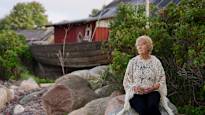VIIMSI/TALLINNA Estonian Mari-Ann Kelamin the first childhood memory is vivid. A three-year-old girl walks with her grandmother in the forest.
– We found a tombstone there. It was interesting that the grave was not that of a person but of a horse, Kelam recalls.
The forest was located in the state of Bavaria in southern Germany. Kelam was born in 1946 in the Ansbach refugee camp to Estonian parents.
Two years earlier, Nazi German troops had begun to withdraw from Estonia. The Red Army of the Soviet Union came crashing down behind. One million Estonians faced difficult choices.
When the advance of the Red Army in Estonia accelerated in mid-September 1944, a huge mass exodus began on the west and north coast of Estonia.
– My parents decided to leave because they had experienced the first year of the Soviet occupation. All those horrors, Kelam says.
The Soviet Union occupied Estonia from the summer of 1940 until Nazi Germany occupied Estonia in the summer of 1941.
– My mother was deeply touched by the fact that co-workers were disappearing daily from their workplace in Päivälehti. My father was just at the age to be mobilized into the Red Army.
Death, distress at sea, thirst and hunger
Mari-Ann Kelam’s father’s job at the Krull machine factory in Tallinn guaranteed a place on the ship that transported refugees to Germany.
Not everyone was so lucky. So in the end we set off with everything that floated. The journey could take up to a week and the sea was rough.
– In the autumn Baltic Sea, we mostly went on small boats, the vast majority of which were in poor condition. We got into trouble at sea, suffered from thirst and saw hunger, the program manager of Vabamu Museum in Tallinn Aive Peil tells.
Vabamu was formerly called the Occupation Museum. It presents the history of Estonia from the years of occupation by the Soviet Union and Germany, as well as the recent history of Estonia. Refugees have their own section.
The ships transported refugees mainly to Germany. Boats were used to go to Sweden either directly or through Finland.
Two refugee ships were bombed into the depths
There were about 80,000 refugees in total. An estimated 6–9 percent of those who fled, 5,000–7,000 people, died on the way.
– A little girl was found dead on the boat when we got there. She was strangled in her neckerchief. In the overcrowded boat, no one noticed what happened, Peil tells one tragic story.
The trip was also dangerous for those traveling on ships. Two ships carrying refugees, the hospital ship Moero and the navy training ship Nordstern, were sunk by Soviet air and submarine attacks.
The exact number of sunken boats and their drowned passengers is not known.
A nationally traumatic experience
In the deportations of 1941 and 1949, the Soviet Union forcibly transferred tens of thousands of Estonians to Siberia and other parts of the Soviet Union. Car rides are generally considered a national trauma in Estonia.
According to Aive Peili of the Vabamu museum, the wave of refugees across the Baltic Sea in 1944 is definitely like that too.
– It was a very traumatic experience. Running away, Deaths on the way, people losing their minds after drifting for days at sea…
A new uncertainty awaited us there.
– On the one hand, we had reached the free world, but on the other hand, we had to survive there as well. Many refugees have said that the escape was also a ride – self-inflicted.
The wave of refugees in Estonia, called the great flight or the boat flight, was not an undisputed event at the time. Some Estonians considered those who left to be traitors.
– The escape somewhat divided Estonian society. There were arguments: whether to leave or stay, who is a real Estonian, why you don’t defend Estonia, why you run away, says Aive Peil.
A quick return remained a dream
According to Mari-Ann Kelam, the refugees were convinced that the departure would be temporary.
– They believed that they would return soon, because the Western powers would keep their promises and the independence of all countries would be restored.
In the end, the Soviet Union occupied Estonia for almost fifty years from 1944 to 1991.
Kelam’s family continued after the war from Germany to the United States. After living in the United States for more than four decades, Mari-Ann Kelam moved to Estonia in 1993, two years after the restoration of Estonia’s independence.
Resistance continued in the West
According to Kelam, the Estonians who ended up in the great escape to the West ultimately played a decisive role in maintaining Estonia’s state continuity. They kept the independence of Estonia and the illegality of the Soviet occupation always in the consciousness of the Western powers.
– Some fight with weapons, others with words and telling stories, like my grandparents, Kelam says.
Even after the Soviet occupation began, Estonian diplomats remained in their countries of station and continued to represent Estonia there. in Oslo between 1953 and 1992 there was a refugee governmentbut the greatest diplomatic power was exercised by the Estonian consulate in New York.
– Ordinary people who fled to the west also participated in the demonstrations and started to form Estonian communities. Estonian archives, schools, churches were founded, Aive Peil describes.
– This preserved the Estonian culture and also the resistance, which was sometimes suppressed in Estonia.
